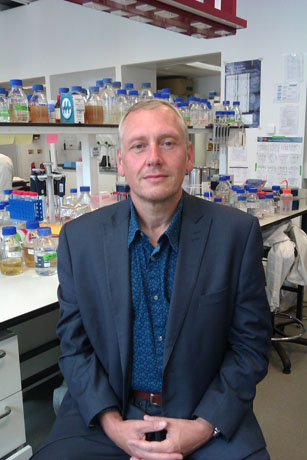Professor Jason Micklefield
The PhysOrg article Scientists strike blow in superbugs struggle said
“Scientists from The University of Manchester have pioneered new ways of tweaking the molecular structure of antibiotics — an innovation that could be crucial in the fight against powerful superbugs.The work, led by chemical biologist Dr Jason Micklefield in collaboration with geneticist Professor Colin Smith, is published online today) and will appear in the next issue of the Journal of the American Chemical Society.
Dr Micklefield said: ‘The results from this work are essential in the development of the next generation of lipopeptide antibiotics, which are critical to combat emerging superbugs that have acquired resistance to other antibiotics.
‘The potent activity of this class of antibiotics against pathogens that are resistant to all current antibiotic treatments makes them one of the most important groups of antibiotics available.
‘Our work relies on interdisciplinary chemical-biology, spanning chemistry through to molecular genetics. It follows the tradition of pioneering work in natural product biosynthesis and engineering that has come out of the UK.’”
Jason Micklefield, Ph.D., FRSC is Chair of Chemical Biology & Director of Research for the School of Chemistry, The University of Manchester, Manchester Interdisciplinary Biocentre. He is on the Editorial Boards of Chemical Communications and Current Organic Synthesis.
Jason is engaged in diverse challenges at the chemistry-biology interface, utilizing techniques and knowledge from organic chemistry including synthesis through to biochemistry and molecular biology.
His main research themes include: biosynthesis and biosynthetic engineering; development and evolution of new biocatalysts; nucleic acid redesign, recognition and template directed synthesis.
Biosynthesis and biosynthetic engineering. Jason is interested in the biosynthesis of nonribosomal peptides. These secondary metabolites include many important therapeutic agents, which are often too complex for effective synthesis. On the other hand, the reprogrammed, engineered biosynthesis of nonribosomal peptide variants, with altered and possibly improved biological activity, is more realistic.
Notably he has elucidated the biosynthetic origins of the calcium dependant antibiotics (CDA) from Streptomyces coelicolor. CDA belongs to the nonribosomal lipopeptide antibiotic family that includes daptomycin, which was introduced into the clinic in 2004 and has become one of the most successful intravenous antibiotics launched in US history.
Nucleic acid redesign, recognition and template directed synthesis. A major focus of Jason’s lab has been the synthesis, conformational analysis and biophysical evaluation of modified nucleic acids and oligonucleotide mimics for therapeutic, diagnostic, bioanalytical and molecular biology applications. For example, novel pyrrolidine-amide oligonucleotide mimics (POM) have been introduced, which contain a pyrrolidine-amide backbone that is protonated at physiological pH, rather than the native ribose-phosphodiester structure.
Small molecule modulators of gene expression which offer rapid, temporal and spatial control of gene expression, are important tools in biological and medical sciences. In particular, the ability to control differentially the expression of multiple genes simultaneously, using distinct small molecule inhibitors or inducers, would be extremely valuable. Unfortunately very few systems exist with these properties.
To this end, Jason is co-evolving small molecule responsive riboswitches (structured mRNA elements in untranslated regions) that function in prokaryotic and eukaryotic cells and respond in a rapid dose-dependent fashion to a wide range of synthetic “designer” ligands. This could have many profound applications in target validation, gene therapy, biosensors and plant biotechnology.
Biocatalysis. He is interested in the mechanism of enzymes, including, decarboxylase, racemases, epoxidases and mutases and their applications in synthesis. For example, methods of directed evolution and genetic selection are used to generate new enzymes with improved properties and altered substrate specificity, that produce valuable homochiral products. Finally, his group was the first to demonstrate the significant advantages of pressurized liquid hydrofluorocarbons as a new media for biocatalysis.
Jason coauthored Site-selective covalent protein immobilization catalyzed by a promiscuous phosphopantetheinyl transferase, Micrometer- and Nanometer-Scale Photopatterning Using 2-Nitrophenylpropyloxycarbonyl-Protected Aminosiloxane Monolayers, Structure and mechanism of an unusual malonate decarboxylase and related racemases, Auxotrophic precursor-directed biosynthesis of nonribosomal lipopeptides with modified tryptophan residue, and Subsurface biomolecular imaging of Streptomyces coelicolor using mass spectrometry. His patents include Enzymatic process for stereo-selective preparation of chemical compounds in hydrofluorocarbon solvents and Process for dynamic kinetic resolution (DKR) of racemic compounds in hydrofluorocarbon solvents.
Jason earned his BSc in Chemistry at the University of Hull in 1989. He earned his Ph.D. in Organic Chemistry at the University Cambridge in 1993 while working with Professor Sir Alan R. Battersby to complete the first total synthesis of Haem d1. This was followed by a NATO postdoctoral fellowship at the University of Washington in Seattle, USA, with Professor Heinz G. Floss, investigating enzyme mechanisms. In 1995 he became a Lecturer in Organic Chemistry at Birkbeck College, University of London, before moving to the University of Manchester Institute of Science and Technology in 1998. He became a Fellow of the Royal Society of Chemistry in 2006. He received the 2008 NPR Lecture Award.
Read Chips are down as Manchester makes protein scanning breakthrough.
